UNIT 5:Discoveries and Inventions
Introductory activity: Read the following text and answer
questions below:
Medical discoveries and inventions
With the idea that modern healthcare is rooted in discoveries of the past,
let’s take a look at seven major medical
milestones of the 20th century.
In 1929, Sir Alexander Fleming, of St. Mary’s Hospital Medical School in
London, United Kingdom, shared his observation that the culture medium
on which a penicillium mold grew attacked certain types of bacteria. But
chemists and bacteriologists working separately were unable to isolate the
active substance in the mold ooze. Mold is a type of fungus that consists
of small organisms found almost everywhere.
In 1940, Oxford researcher Sir Howard Florey brought together a
multidisciplinary team who were finally able to isolate the drug penicillin.
Penicillin became widely popular in the years surrounding World WarIInot only for
the treatment of battle wounds, but also for the treatment of
syphilis. Moreover, penicillin led to a surge in healthcare utilization in thepost-war era.
American scientists John Enders, PhD, Thomas Weller, MD, and Frederick
Robbins, MD, announced in 1949 that they had grown poliovirus in
cultured human embryonic skin and muscle cells, thus taking tissue
culture mainstream. This discovery led to methods of measuring
immunity to polio and the Nobel Prize for the trio in 1953.
As late as 1952, geneticists didn’t know how Deoxyribonucleic acid
(DNA) worked. All of this changed with the 1953 discovery of the double
helix (the DNA double helix is an elegant structure that allows the genetic
information to be stored, protected, replicated, and repaired) by James
Watson, PhD, and Francis Crick, PhD. Their discovery of DNA’s structure
was rooted in Gregor Mendel’s theory on the principles of single gene
inheritance in 1866, as well as Sir Archibald Garrod’s elucidation of the
inheritance pattern of alkaptonuria (black urine disease) which is a very
rare inherited disorder that prevents the body fully breaking down two
protein building blocks (amino acids) called tyrosine and phenylalanine)
in 1923.
Drs. Watson and Crick, as well as Maurice Wilkins, PhD, were honored with
the Nobel Prize for Physiology or Medicine in 1962 for their discovery.
In addition to Dr. Wilkins, Rosalind Franklin, PhD, helped produce x-ray
diffraction images instrumental to the deduction of Drs. Watson and Crickthat DNA is a three-dimensional helix.
Comprehension questions
1. Outline major medical milestones of the 20th century.
2. Explain how penicillin was discovered.
3. Write in full form of the acronym DNA.
4. Explain Archibald Garrod’s contribution to the discovery of thedouble helix in 1923.
Vocabulary practice
Use each of the following words in your own sentence.
1. milestones
2. penicillium mold
3. mold ooze
4. penicillin
5. surge
6. poliovirus
7. cultured
8. embryonic skin
9. muscle cells
10.culture mainstream
11.single gene inheritance
12.elucidation13.physiology
Activity
Write a composition explaining why penicillin is no longer commonlyprescribed to treat infections. Tell other antibiotics that are in use today.
Recounting a famous discovery
Language use
Activity 1
Discussion
Share your opinions about these questions and compare your answerswith other classmates.
1. Explain the role of scientists in our communities.
2. Think about the life people in the past lived without advanced
science and technology. Compare their life with the life today
where we live in a modern scientific world.
3. How have scientists made our lives more comfortable and
interesting?4. Whom do you regard as your favourite scientist? Why?
Describing a famous invention
Activity 1
Discussion
1. Share with your classmates or Biology teachers what you know
about Gregor Mendel. Explain the relevance of his discovery about
genetics to our lives.2. Discuss why he is referred to as “the father of genetics”.
Activity 2
Read and enjoy the story about Gregor MendelGregor Mendel, the father of genetics
Mendel was unhappy with how inheritance of traits was being
explained
People had known for millennia about selective breeding. They knew
that by breeding from those individuals that showed the most desirable
traits, future generations were more likely to show these desirable traits.
• Guard dogs might be bred from parents that were loyal and
friendly to their owners, but were suspicious or even aggressive
with strangers.
• Cattle might be bred from cows that yielded the most milk and
bulls that yielded the most meat.
• Wheat might be kept and sown the following year from those
plants which had produced the most abundant crop.
The main theory of heredity in Mendel’s time was that offspring were
a smooth blend of their two parents’ traits.
Mendel set himself the very ambitious task of discovering the laws of
heredity
To achieve this, he embarked on a mammoth-sized, highly systematic,
eight-year study of edible peas, individually and carefully recording the
traits shown by every plant in successive generations.
His work involved growing and recording the traits in about 30,000
plants.
One of the keys to his success was breeding from closely related peavarieties which would differ in only a small number of traits
The seven traits of pea plants that Mendel chose to study: seed wrinkles;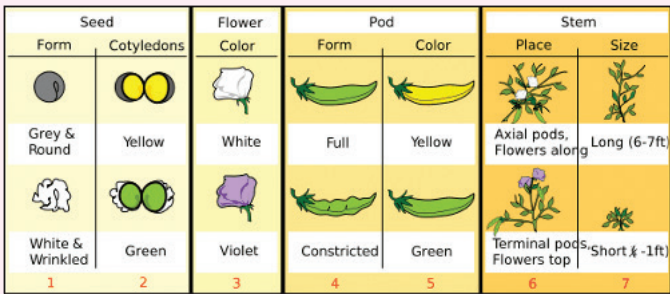
seed colour; seed-coat colour, which leads to flower colour; pod shape;
pod colour; flower location; and plant height.
Mendel’s results for flower colour
Mendel found the same results for all traits, but we shall look at flower
colour as an example.
When Mendel bred purple-flowered peas (BB) with white-flowered peas
(bb), every plant in the next generation had only purple flowers (Bb).
When these purple-flowered plants (Bb) were bred with one another
to create a second generation of plants, some white flowered plants
appeared again (bb).
Mendel realised that his purple-flowered plants still held instructions
for making white flowers somewhere inside them.
He also found that the number of purple compared to white was
predictable.
75 percent of the second-generation plants had purple flowers, while
25 percent had white flowers. He called the purple trait dominant andthe white trait recessive.
A Punnett square
Both of the starting plants have purple flowers but they contain the genes
for purple (B) and white (b). The pollen from the male plant fertilises
the egg in the female flower. In this variety of plant, purple flowers are
caused by a dominant gene (B). Dominance is indicated by a capital
letter. White flowers are caused by recessive genes, indicated by the
small letter (b). Both the male and female parent plants in the diagram
above carry the dominant gene B for purple and the recessive gene b
for white flowers. The ratio of purple flowers to white flowers in their
offspring will be 3:1 as shown in this diagram. For a white flower to
appear, the offspring must inherit the recessive gene from both parents.
Purple appears with any other combination of genes inherited from theparent plants. (Image by Madeleine Price Ball)
Mendel’s conclusions
Mendel’s most important conclusions were:
• The inheritance of each trait is determined by something (which we
now call genes) passed from parent to offspring unchanged. In other
words, genes from parents do not ‘blend’ in the offspring.
• For each trait, an organism inherits one gene from each parent.
• Although a trait may not appear in an individual, the gene that can
cause the trait is still there, so the trait can appear again in a future
generation.
Scientists who did research later found that Mendel’s results do not only
apply to pea plants. Trait inheritance in most plants and animals, including
humans, follows the patterns Mendel recorded.In Mendel’s honour, these very common patterns of heredity are now called
Mendelian inheritance.
Activity 3
Write notes about Mendel’s discovery about genetics.
Activity 4
In your own words, explain what you learnt about Mendel’s genetic
discovery.
Activity 5
Research
Visit your computer laboratory. Use the internet to carry out research
about two scientists and make notes to compare their discoveries.Compare your work with that of other classmates.
Describing a famous scientist
Activity 1
Discussion
There have been many scientific inventions and discoveries, all of which
are very useful in solving our world problems; such as in transport,
communication, and health, among others. Think about the transport
sector. Before, people would travel miles and miles on foot but today,
someone can travel around the world in just a few minutes or hours.
Which scientists do you know of that made discoveries, inventions or
innovations in the transport sector? What did he or she invent to solveour transport challenges?
Activity 2Read and enjoy the passage below carefully
Orville and Wilbur Wright are credited with inventing the aeroplane.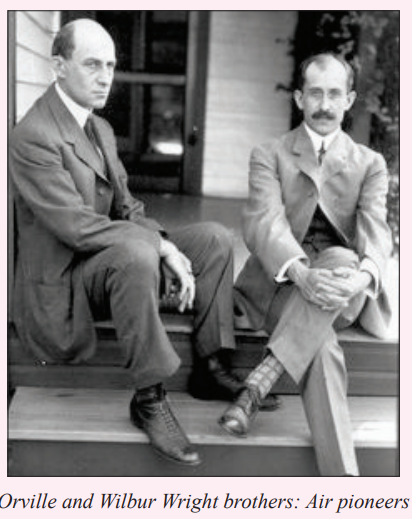
They were the first to make a successful human flight with a craft that
was powered by an engine and was heavier than air.
This was quite a milestone and impacted on transportation throughout
the world. It took some time to perfect, but in later years people could
travel long distances in much less time. Today, trips that previously
would have taken months by boat and train, can be made by plane in afew hours.
Orville and Wilbur Wright were born four years apart, in different cities.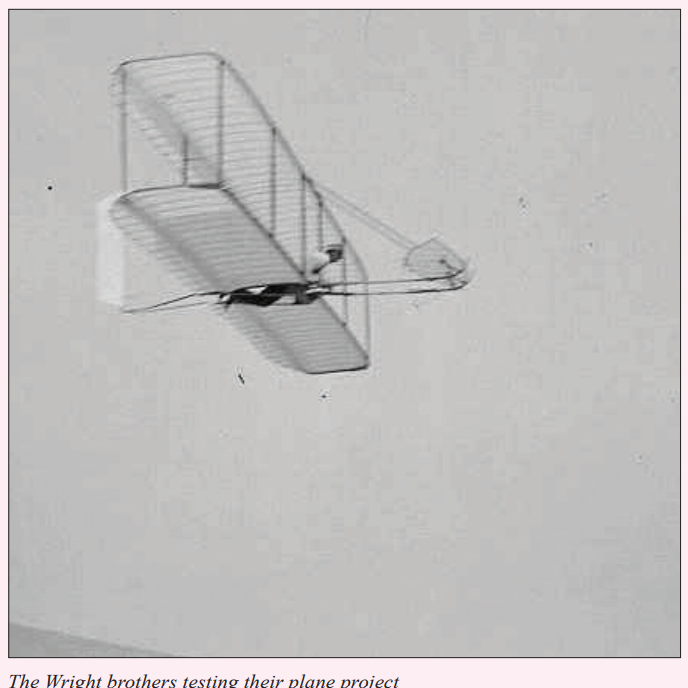
They shared a curiosity about the world and a love of tinkering that
would make history
Wilbur was born in 1867 on a small farm near Millville, Indiana. Orville
was born in 1871 in a house in Dayton, Ohio. Their father was a bishop
in the Church of the United Brethren in Christ. (The Wrights had five
children in all: Reuchlin, Lorin and Katharine were the names of the
other children.)
Life in the Wright house was strict but loving. Both parents encouraged
their children to enjoy school and learn as much as they could. A large
library of books about all kinds of subjects helped the Wright children
quench their thirst for knowledge from a very early age.
Orville and Wilbur’s fascination with flight began with a present their
father gave them—a flying toy. It had a paper body and other parts made
of cork and bamboo. Rubber bands provided the power. The young boys
(7 and 11) were thrilled to make the little toy fly across the room, so
much so that they broke it. They remembered how it looked, though,
and promised each other that someday they would fly in the air, just
like the little toy.
The boys continued to be interested in mechanical things and flight.
Orville sold kites at school to make money. Wilbur started reading all
he could about how birds flew and machines worked.
Though the boys were good students, neither graduated from high
school. (Not many did in those days, actually.) Wilbur was hit in the face
with a baseball bat when he was a teenager and suffered from irregular
heartbeats the rest of his life. He stayed at home for awhile, during
which time their mother developed tuberculosis (which, at that time,
was a devastating disease with no known cure). Wilbur recovered and
then stayed at home to care for his mother. Orville left high school on
his own, to start a printing business. He and Wilbur designed a printing
press that worked very well. The two later sold the printing business
and opened a bicycle shop. They were both very good mechanics and
could fix just about anything anyone asked them to fix. (They inherited
this skill and desire from their mother, who was the family mechanic.)
It was in the bicycle shop that the idea of the aeroplane was born.
The Wrights had made kites, very large ones, in fact. By 1900, they
were making ones so large that people could fly in them, sort of. These
were called gliders, and Orville and Wilbur actually built one or two
that were large enough for a person to ride in. They flew on nothing but
air current, and the person could get a ride of about 10 seconds before
the glider came down to the ground.
They flew the machine three times that day, mainly because each time
they managed to land without crashing. Each flight was a bit longer,
and the final flight of the day carried Wilbur 852 feet. He was in the airfor a full 59 seconds.
The Wright plane wasn’t a hit overnight, however. No one else knew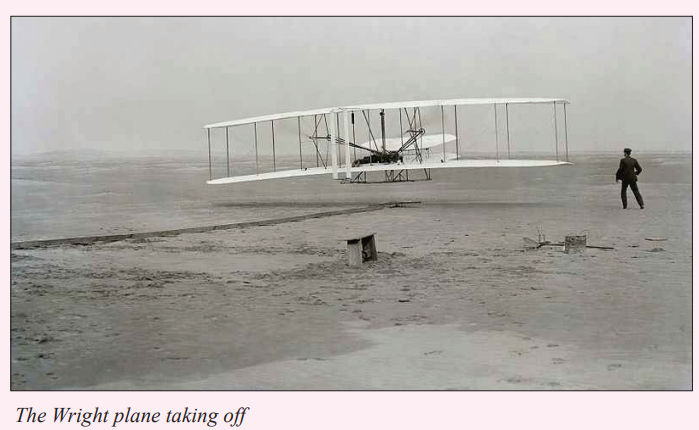
about the flight. The brothers returned to their bicycle business in Dayton
and also continued to refine their aeroplane invention. Not long after that,
they had built a plane that could fly 25 miles and go 40 miles an hour.
They even had a model that could fly circles—and not go off-balance
and crash to the ground!
In 1908, Wilbur flew one of their planes in front of royalty in Europe.
In the same year, the rest of America discovered the aeroplane when a
newspaper reporter witnessed a flight and wrote about it. The story was
soon in newspapers all over the country. The Wrights were suddenlyfamous.
The very next year, they opened a business to make aeroplane, the
Wright Co. They found great fame and success making aeroplane.
Unfortunately, Wilbur died in 1912 of typhoid fever. Orville lived
on, however, eventually selling his business and watching his and hisbrother’s dream become a reality in the modern industrial age.
Exercise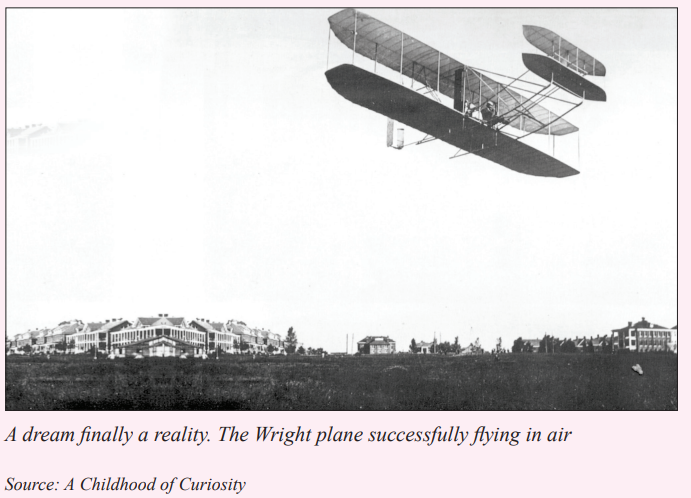
Answer these questions about the passage you have read
1. Why is Orville and Wilbur’s invention of a plane referred to as a
“milestone” in air transport?
2. Explain what inspired the Wright brothers to invent the aeroplane.
3. How was the idea of making a flying plane born in the bicycle
shop?
4. Explain how the gliders that the Wright brothers made worked.
5. How did the aeroplane invention by the Wright brothers get knownin Europe?
Activity 3
Imaginary interview
The Wright brothers did not go far in school. Actually they were about the
same level as we in Senior Four or Five, yet they made this spectacular
invention.
Imagine you met the Wright brothers. Think about the questions you
would ask them about their aeroplane invention. Use their knowledge to
think about a scientific invention you could make. Describe your amazing
scientific invention or discovery and explain the process you would go
through to create it. Describe the functionality and the problem it would
solve. Present your description in an expository essay. Compare youranswers with those of your classmates.
Before modern-day scientists explained natural forces using scientific
inquiry and investigations, early man used to explain natural forces using his
own knowledge and interpretation; most of which, actually, relied heavily on
divine philosophy. Scientists have helped much to demystify these natural
phenomena. They have also helped us to make scientific predictions and as
a consequence take precautionary measures. For example, we can explainthe concept of global warming, diseases, nutrition, etc. using science.
Activity 4
Discussion
Most of the earth’s forces such as gravitation pull or kinetic forces are
explained through physics.
(a) Who would you regard as the father of physics?
(b) What did he or she do?
(c) Describe his or her life.
(d) Do you think scientists are born scientists; or they are
inspired to dwell on science as they grow up?Activity 5
Read and enjoy the life story of the famous scientist, Chen-Ning Yang
The famous scientist: Chen-Ning Yang
Chen-Ning Yang thought the unthinkable and won the 1957 Nobel Prize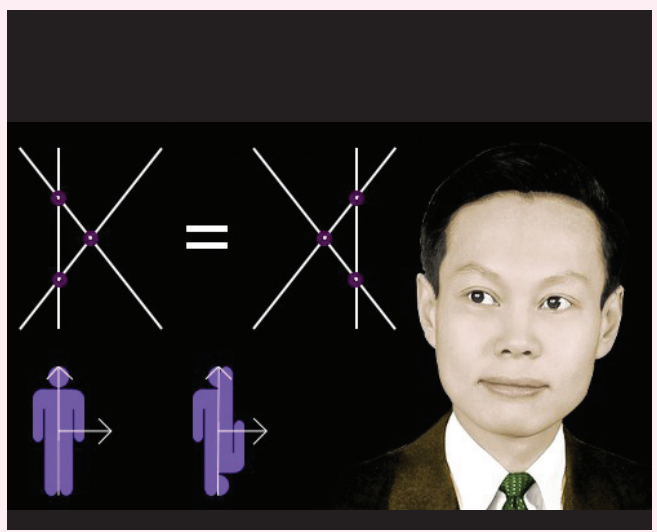
in physics. Yang and his co-worker Tsung-Dao Lee showed that parity
– a property that physicists had believed was always conserved – like
energy, momentum and electric charge – need not be conserved.
Yang also worked with Robert Mills to produce Yang-Mills theory, which
today lies at the heart of the Standard Model in physics.
Early life and education
Chen-Ning Franklin Yang was born on 22 September 1922 in the city
of Hefei, China.
His family moved to Beijing when he was young after his father,
WuChih, became a professor of mathematics at Tsinghua University. His
mother, Meng-hua, was a housewife.
Yang was schooled in Beijing until 1937, when the Japanese invasion of
China forced his family to return to Hefei, and then, a year later, move to
the city of Kunming. The Japanese army did not reach Kunming in the
south-west of China, although it was bombed by the Japanese air force.
Yang enrolled at the National Southwestern Associated University in
Kunming and was awarded a bachelor’s degree in physics in 1942.
In 1944 he was awarded a master’s degree in physics for his work in
statistical mechanics. He was awarded his degree by Beijing’s Tsinghua
University, which had relocated to Kunming.
Yang worked as a teacher until he won a United States government
scholarship in 1946, which took him to the University of Chicago. There
his doctoral advisor was Edward Teller, the father of the hydrogen bomb.
In 1948 Yang was awarded a PhD in physics for his work on nuclearreactions.
Chen-Ning Yang’s research work
After the award of his PhD, Yang stayed at Chicago for a year, working
with one of the giants of 20th century physics, Enrico Fermi.
In 1949 he was invited to become a theoretical physics researcher at the
Institute for Advanced Study in Princeton.
The institute had been founded in 1930 with the goal of employing the
best mathematicians and physicists in the world; Albert Einstein was
there from 1933 until his death in 1955.
Parity conservation
Atom smashing
During the 1950s, increasingly complex results had been coming out
of particle accelerators and cosmic ray detectors, causing increasing
confusion among physicists.
The accelerators were pushing ions and particles to enormous speeds,
then smashing them into one another. Physicists hoped the debris from
the collisions would reveal more about what matter is and how it behaves.
Cosmic rays – high energy particles reaching the Earth from the sun and
the stars – also produced interesting debris.
The debris from both accelerators and cosmic rays contains subatomic
particles, which are generally unstable, quickly decaying into other
particle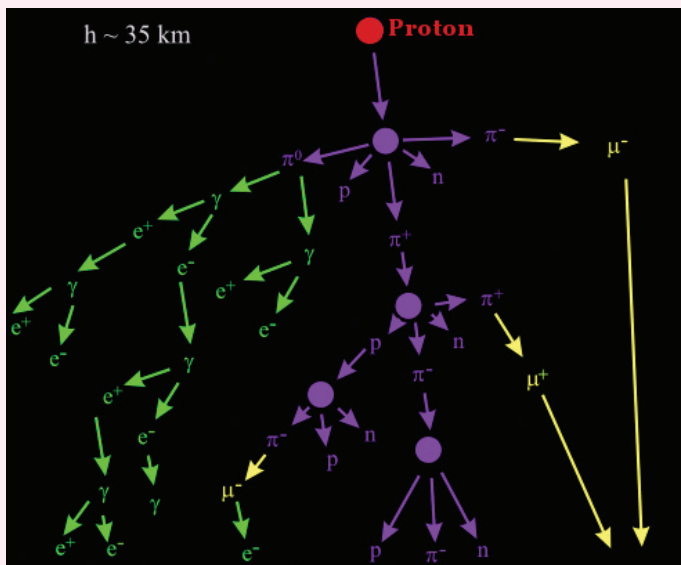
A very high energy proton (red) ejected by the sun enters the Earth’s
atmosphere. We call this a cosmic ray. It collides with a particle high
in the Earth’s atmosphere, producing a shower of subatomic particle
debris, which can help reveal some of the basic properties of matter.
The Meson problem
Two unstable particles, the theta-meson and the tau-meson, were causing
a lot of heads to be scratched.
In some senses, the theta-meson and the tau-meson looked as if they
might be the same particle: their masses and the average time they took
to decay into other particles seemed to be the same. The theta-meson
and the tau-meson both decayed into pi-mesons, usually known as pions.
BUT the theta decayed to produce two pions, while the tau decayed toproduce three pions
The theta and tau particles seemed to be identical, except the theta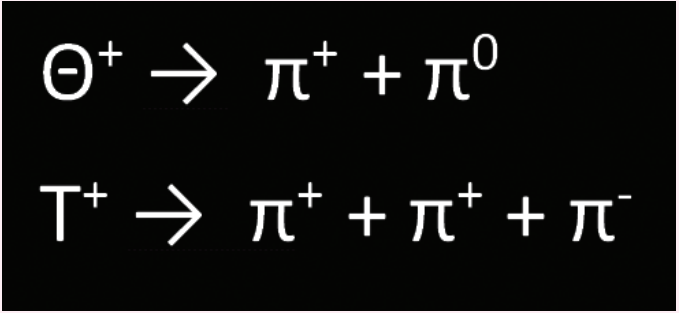
decayed to give two pions, while the tau produced three pions.
Most physicists took it as a fundamental law of the universe that when
any particle decayed, its parity stayed the same.
Parity must never be broken: this meant, in a very simplified way, that
the same particle could not possibly decay sometimes into two pions,
and at other times into three pions. Physicists believed there was a
fundamental symmetry in the universe. If parity were broken, the
fundamental symmetry they believed in would also be broken.
Physicists regarded parity as a property that was conserved in the same
way that energy, momentum, and electric charge are always conserved.
Yet the only difference physicists could find between the theta-meson
and the tau-meson was that they decayed differently. Otherwise these
mesons seemed identical.
A daring hypothesis: Broken parity
What if there really were only one meson – a meson that sometimes
decayed into two pions and sometimes into three pions?
Most physicists thought the idea was ludicrous; if there was one thing
they could rely on Mother Nature to do, it was to preserve parity andsymmetry.
Enter Yang and Lee
At the Institute for Advanced Study, Yang had started working with
Tsung-Dao Lee. They had actually first met in China at the National
Southwest University.
Yang was now a full professor of theoretical physics, having been
promoted in 1955.
In summer 1956, Yang and Lee thought the unthinkable. What if parity
really could be broken? At this time, Yang was 34 and Lee was 29 years old.
The meson decay they were looking at involved the weak nuclear force
– the force responsible for nuclear fission and beta particle emission
from atomic nuclei.
The two physicists read everything they could and carried out a large
number of calculations; they wanted to see if there truly was a fundamental
physical law preventing parity being broken for interactions involving the
weak nuclear force. There was already good evidence that parity could
not be broken for interactions involving the strong nuclear force.
They published their work late in 1956, showing they could find nothing
to stop parity being broken for weak interactions and they described
experiments they had devised which could prove whether parity was
broken.
The unthinkable is true = Nobel Prize
A team of physicists at the Cryogenics Physics Laboratory at the National
Bureau of Standards in Washington carried out one of the experiments
designed by Yang and Lee, cementing Yang and Lee’s place in the
history of science.
In 1957 Yang and Lee won the Nobel Prize in Physics: they had
thought the unthinkable, their calculations showed the unthinkable was
possible, and they had devised experiments that had established that the
unthinkable was actually true: the theta and tau mesons were actually
the same particle and Mother Nature did not preserve parity. Symmetry
had also been broken. At a deep level, this means that nature can tell thedifference between left and right.
In the more sombre words of the Nobel Prize Committee, Yang and
Lee’s prize was for their “penetrating investigation of the so-called parity
laws which has led to important discoveries regarding the elementary
particles.”
Even in the face of the theta-tau puzzle, most physicists had not seriously
contemplated the possibility of parity breaking. Physics giant Richard
Feynman was pleased that at one point he gave the odds of parity
breaking being discovered as low as 1 in 50!
Particle physics had been held back for years by the incorrect assumption
that parity could not be broken in weak interactions. Yang and Lee setparticle physics free again
The theta-tau puzzle was solved when Yang and Lee paved the way for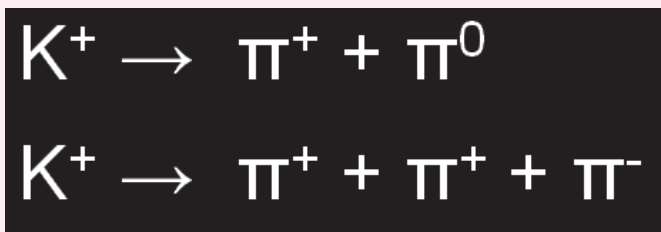
the discovery that tau and theta mesons are identical: they represent
different behaviours of the K+
meson. Sometimes a K+
meson decays toform two pions; sometimes it decays to form three pions.
Exercise
Answer these questions about the passage.
1. Use your own words to explain the important scientific principle
that Yang discovered.
2. By his father being a professor of mathematics at Tsinghua
University, do you think this inspired Yang’s discovery of the
physics law? Explain your opinion.
3. At only 26 years, Yang had already attained a PhD in physics, the
highest degree award in any field of study. Explain the contribution
of his education to his important discovery.
4. Carry out research about Professor Albert Einstein and find out
why he is known as the father of modern physics. Do you think
that Yang’s working in the same university with Professor Albert
Einstein, broadened his mind to discover the scientific law?
Explain your opinion.
5. In your own words, explain precisely what the Meson problem was
all about and the confusion it was causing among most physicists.6. Explain how Yang solved the parity puzzle.
Describing African scientists
Activity 1
Discussion
We have discussed European, American and Asian scientists in the
previous sub-units. In this sub-unit, we are going to discuss African
scientists and their prolific innovations, inventions and discoveries.
Are there some African scientists you know of? Share them and their
scientific works with your group members. Choose a group secretary to
present your findings to the class for further discussion and comparison.
If you do not know any African scientist, then visit the internet facility of
your school laboratory. If your school does not have a computer, conductresearch from science textbooks from your library or ask your teachers.
Activity 2
Research on African scientists
Visit your school laboratory and find out about the life and scientific
discoveries or works of these famous African scientists. Compare your
findings with those of your classmates. If your school does not have acomputer laboratory, ask your science teachers.
Speculating about the future
Third conditional
Activity 1
Look at this sentence. What does it mean?
If Alexander hadn’t discovered antibiotics, many people would have
died.
Activity 2
Look at the scientists and their discoveries or inventions that you have
learnt about in this unit. Predict what would have happened if they hadn’t
made those discoveries. Write sentences about your speculations.
Activity 3
Carry out research about the scientists in the table below and their
discoveries or inventions on the internet, or by asking your science
teachers, and write sentences speculating what would have happened if
they hadn’t made their discoveries. Compare your sentences with thoseof your classmate

Activity 4
Gap filling
Predict what would have happened in these sentences and complete them.
1. If the Wright brothers hadn’t invented the aeroplane, ……………
2. If their father hadn’t given them a gift of a toy plane, the Wright
brothers ………………
3. ………………, the idea of the aeroplane wouldn’t have been born.
4. If the Wright brothers hadn’t made the kites, …………….
5. If the newspeople hadn’t covered the first flight, …………….
6. If Mendel hadn’t set for himself the ambitious task of discovering
the laws of heredity, ……………………
7. If Chen-Ning Yang hadn’t studied physics,…………………..
8. If the Meson problem hadn’t persisted, Yang ………………..
9. If Dr. Phillip Emeagwali hadn’t developed the world’s fastest
computer, …………..
10. If Professor Gebisa Ejeta ………………, the sorghum breedingresearch would not have been successful.
Grammar highlight: Third Conditional
We can use the third conditional to talk about ‘impossible’ conditions.
Impossible because they are in the past and we cannot change what
has happened.
Examples
If I had worked harder at school, I would have got better grades.
If I had had time, I would have gone to see him. But I didn’t have time.
If we had bought that house, we would have had to rebuild the kitchen.
If we had caught the earlier train, we would have got there on time but
we were late.Notice that the main clause can contain ‘would’, ‘could’ or ‘might’.
If I had seen him at the meeting, I would have asked him. (But he wasn’t
there so I didn’t.)
If I had seen him at the meeting, I could have asked him. ( But he wasn’t
there so it wasn’t possible.)
If I had seen him at the meeting, I might have asked him. (But I’m not
sure. Perhaps if the opportunity had arisen.)
If I had paid more attention in class, I would have understood the lesson.
Also notice that sometimes the ‘if clause’ is implied rather than spoken.
I’d have done it. (“if you had asked me but you didn’t.”)
I wouldn’t have said that. (“if I’d been there.”)He wouldn’t have let him get away with that. (“if he had tried that with me.”)
Revision on the third conditional
Activity 1Gap filling
In this exercise, you will practise forming the third conditional. Basing
on the example sentence, complete the third conditional sentences by
filling in the spaces. For example:
I didn’t pass the test, because I hadn’t studied hard enough.
“If I had studied harder, I would have passed the test.”
1. He crashed his car because he fell asleep while driving.
If he …………… asleep while driving, he …………… his car.
2. We couldn’t go to the concert because we didn’t have enough
money.
If we ………… enough money, we ……… to the concert.
3. I lost my job because I was late for work.
I …………… my job if I …………… late for work.
4. The wind was so strong that the bridge collapsed.If the wind …………… so strong, the bridge …………… .
5. I couldn’t call Mutesi because I had lost her number.
…………… Mutesi if I …………… her number.
Exercise
Multiple choice
For each question, read the situation and choose the best sentence using
the third conditional.
1. I wasn’t thirsty. I didn’t drink the lemonade.
A. If I was thirsty, I would drink the lemonade.
B. If I had been thirsty, I would’ve drunk the lemonade.
C. If I would have been thirsty, I drank the lemonade.
2. I didn’t know Butera was in town. I didn’t call her.
A. If I had known Butera was in town, I would have called her.
B. I had called Butera if I had know she was in town.
C. I would had called Butera if I have known she was in town.
3. I didn’t know watching this documentary was important for our
exam. I didn’t watch it.
A. If I knew this documentary was important, I had watched
it.
B. If I would have known this documentary was important, I
had watched it.
C. If I had known this documentary was important, I would’ve
watched it.
4. I walked home from the disco. My friend was too drunk to drive.
A. I hadn’t walked home from the disco if my friend wasn’t
too drunk to drive.
B. I wouldn’t have walked home from the disco if my friend
hadn’t been too drunk to drive.
C. I wouldn’t had walked home from the disco if my friend
hadn’t been too drunk to drive.
5. I didn’t go to the store. I thought it closed at 5 pm. It closed at 6 pm.
A. If I had known the store had closed at 6 pm, I would’ve
gone
B. If I knew the store would have closed at 6 pm, I would’ve gone.
C. I would’ve gone to the store if I know it had closed at 6 pm.
6. I ate the yoghurt in the fridge. I thought it was mine, not yours.
A. If I would have known the yoghurt was yours, I wouldn’t
have eaten it.
B. If I had known the yoghurt was yours, I wouldn’t have eaten
it.
C. I hadn’t eaten the yoghurt if I knew it was yours.
7. I am really hungry now. I didn’t have any breakfast.
A. If I had some breakfast, I wouldn’t be hungry now.
B. If I would had had some breakfast, I wouldn’t be hungry
now.
C. If I had had some breakfast, I wouldn’t be hungry now.
8. I didn’t see Tony at the party. I wanted to speak to him about his
vacation in Kenya.
A. If I saw Tom at the party, I would’ve spoken to him.
B. If I had seen Tom at the party, I would’ve spoken to him.C. If I would have seen Tom at the party, I would’ve spoken to him.
Predicting discoveries and inventions in the
future
Activity 1
Research
We are witnessing many scientific innovations like the computer and
satellite technology and indeed many more inventions, discoveries and
innovations are in the pipeline. You have probably heard people predict
some of them. Discuss the scientific inventions you think will happen in
the coming years. If you do not know, then use the internet to find outor ask your science teachers and community members.
Activity 2
Research
In groups, study the photographs carefully. Describe them with your
classmates.
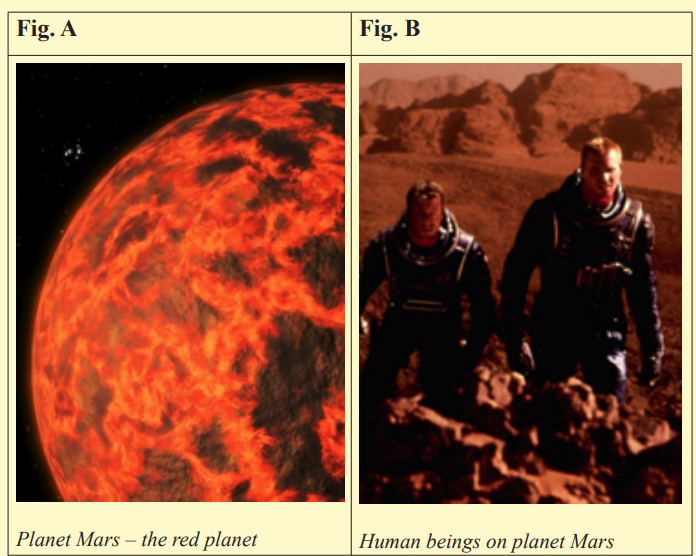
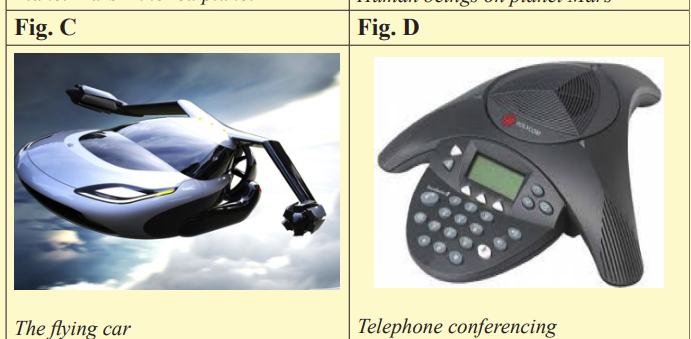
Answer these questions
1. Look at Fig. A of the planet Mars, also called the red planet. Find
out why it is called the red planet. Have you heard of the one-way
ticket to Mars? It is an expedition in which a USA billionaire
called Elon Musk has invested to land humans on planet Mars to
live there permanently after the scientists in Fig. B discovered that
the planet could support human life. Visit your school’s internet
laboratory, search for the topic ‘one-way ticket to Mars’. Write an
essay about how the whole process will be conducted, the possible
challenges humans who will live on the planet will face and the
possible mitigation measures scientists have put in place.
2. Look at Fig. C (the flying car). It is anticipated to solve the problem
of traffic jams in towns and cities. Again use the internet to find
out how the car will operate.
3. Fig. D is a telephone conferencing gadget. Conference means a
gathering. This gadget is already in use with plans to modify it so
that it can address hundreds of thousands or millions of people in
a community. How does it work? Find out from the internet.
4. Have you heard of the Airbus; of the road that will be constructed
to rotate around the world cutting through the major cities of the
world; food that will be grown in floating gardens in air; cities
and towns built on water by scientists; the first head transplant
that will take place in December 2017, by Professor Doctor Sergio
Canavero, an Italian neurosurgeon; etc? Research about all of them
and any other astonishing future or current scientific inventions,
innovations and discoveries and find how they will affect the
world. Present your work in an essay.Please work together and compare your answers.
Future perfect
Activity 3
Discussion
1. Predict the inventions that will happen in future. What do you
think life as influenced by scientific innovations will be like in
the year 2500?
2. What impact do you think these scientific inventions, innovations
and discoveries will have on our lives?
3. Do you think by 2500, a cure for HIV/AIDS will have been found?
4. What do you predict will be the effect of science and technology,
including ICT, on the lifestyles of the people who will be livingby that time, 2500 and beyond?
Exercise
Use the predictions to write sentences or paragraphs about those scientific
inventions and discoveries and the effect they have on our lives and the
environment using the future tense ‘will’. Compare your answers with
those of your classmates.
Example
By the year, 2050, it is predicted by the UN that there will be two billion
more people in the world, creating a demand for 70 percent more food. By
that time, 80 percent of us will be living in cities, and most of the food will
be farmed in the cities. I predict that scientists will invent air floating farmsto meet the very great food demand for the urbanites
